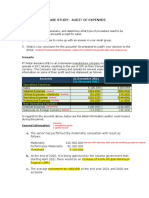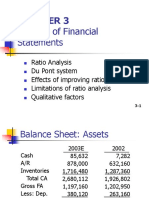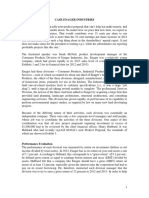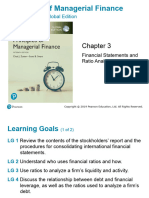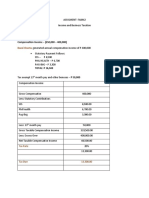S5. Accounting Analysis
S5. Accounting Analysis
Uploaded by
João Maria VigárioCopyright:
Available Formats
S5. Accounting Analysis
S5. Accounting Analysis
Uploaded by
João Maria VigárioOriginal Title
Copyright
Available Formats
Share this document
Did you find this document useful?
Is this content inappropriate?
Copyright:
Available Formats
S5. Accounting Analysis
S5. Accounting Analysis
Uploaded by
João Maria VigárioCopyright:
Available Formats
TOPICS FOR THE SESSION
Accounting analysis
Key concepts
Exercise 2 debrief
FINANCIAL ANALYSIS & FORECASTING| Joana Cardoso Fontes
Exercise 2
A: Depreciation and tangible assets
In 2012 Lufthansa reported that it depreciated its aircraft over 12 years on a straight-line
basis, with an estimated residual value of 15% of initial cost.
In contrast, industry peers such as Air France-KLM and British Airway were using straight
line depreciation rates between 4 and 5 percent (of initial cost).
For analysts these differences raised several questions.
Questions:
1. What are the potential explanations for the different policies?
2. Calculate the differences in the depreciation rates and explain the impact of the
differences on the FS;
3. Assume that you as analyst consider that there is no reasons for different policies and
that Lufthansa’s depreciation rate should match the one of its peers ones. Show the
adjustments to the balance sheets and to the 2012 income statement.
in millions €
Aircraft cost 1/1/2012 22,486
Accumulated depreciation 1/1/2012 12,238
10,248
FINANCIAL ANALYSIS & FORECASTING| Joana Cardoso Fontes
IMPACT ON BALANCE SHEET (due to accumulated depreciation)
Aircraft cost, 1/1/2012 22,486
Depreciable cost = cost *(1-15%) 19,113
Accumulated depreciation, 1/1/2012 12,238
old net amount@1/1/2012 10,248 = cost - accumulated depreciation
Accum depreciation/depreciable cost 64.03% =12,238/19,113 =% already depreciated
useful life 12
average age of aircraft 7.68 = useful life* % already depreciated
new rate 4,5%
(a) average age of aircraft 7.68
(b) new depreciation rate 4.50%
(c) Aircraft cost, 1/1/2012 22,486
Accumulated depreciation, 1/1/2012 (d) = (a)*(b)*(c) 7,775
new net amount@1/1/2012 14,711 = (c) -(d)
change in asset base@1/1/2012 4,463
IMPACT ON NET INCOME
Old rate: depreciation expense per year: 7.083% 1,593 = 7.083%* depreciable cost (=19,113)
New rate: depreciation expense per year: 4,5% cost 1,012 = 7.083%* depreciable cost (= 22,486); no residual value
change in depreciation expense year 2012 -581
before after
BS IS BS IS DIF
01/01/2012 10,248 14,711 4,463
31/12/2012 8,655 1,593 13,699 1,012 -581
FINANCIAL ANALYSIS & FORECASTING| Joana Cardoso Fontes
Exercise 2
B: Impairments in assets and accumulated impairment
Assume that you are an analyst following the company XPTO. The company
construct a new 500m2 plant in the beginning of 20X1 for €1 Million. The selling
price per m2 indicated by a property specialist is €1.200 as of Dec 31 20X2. The
company disclosed in the notes to its financial statements as of Dec 31, 20X2 that:
Depreciation method: straight line
Useful life: 20 years
Value in use: 800.000€
Questions:
• Analyze whether there is any impairment and provide the adjustments needed
as of Dec 31 20X2.
• What are the impacts of not recognizing the impairment?
FINANCIAL ANALYSIS & FORECASTING| Joana Cardoso Fontes
1.20X1 12.20X1 12.20X2
purchase price 1,000,000 1,000,000 1,000,000
depreciation 50,000 50,000
accumulated depreciation 50,000 100,000
carrying amount 1,000,000 950,000 900,000
FV less costs to sell 600,000 =500*1200
Value in use 800,000
Impairment loss 100,000 net income
Revised carrying amount 800,000
Impacts of not recognizing impairment:
Assets’ base overstated
Delay in the recognition of a loss
(instead of recognizing loss now, firm recognizes greater expense over useful life; if
firm sells asset, recognizes a loss only when selling asset)
FINANCIAL ANALYSIS & FORECASTING| Joana Cardoso Fontes
Exercise 2
C: Off balance sheet assets
Bayer, one of the largest chemical and pharmaceutical companies in the world, does not
capitalize most of its R&D costs because regulatory uncertainties surrounding the
development and marketing of new products mean that the recognition criteria for research
expenditures are rarely met. The R&D outlays expensed every year over the period 2009-
2014 were:
R&D outlay
Year
(€ bn)
Assume that R&D occurs evenly throughout the
year, only half a year’s amortization is taken in the
2014 3.6
year of spending and that the average life of R&D
2013 3.2
2012 3.0
is five years.
2011 2.9
2010 3.1
2009 2.7
Required: Calculate the value of the R&D asset as of 31/12/2013, as if it the R&D
expenditures were capitalized. Show the impacts in the financial statements as of
31/12/2013 (ignore taxes).
FINANCIAL ANALYSIS & FORECASTING| Joana Cardoso Fontes
accumulated depreciation
2009 2010 2011 2012 2013 Net amount
2009 50%*2.7/5 2.7/5 2.7/5 2.7/5 2.7/5 0.54 0.5*2.7/5 0.27
2010 - 50%*3.1/5 3.1/5 3.1/5 3.1/5 0.62 1.5*3.1/5 0.93
2011 - - 50%*2.9/5 2.9/5 2.9/5 0.58 2.5*2.9/5 1.45
2012 - - - 50%*3.0/5 3.0/5 0.6 3.5*3.0/5 2.1
2013 - - - - 50%*3.2/5 0.32 4.5*3.2/5 2.88
2.66 7.63
FINANCIAL ANALYSIS & FORECASTING| Joana Cardoso Fontes
R&D outlay Proportion to be Asset Expense
Year
(€ bn) capitalized in 31/12/2013 31/12/2013 2013
2013 3.2 (1-1/5*50%) 2.9 0.32
2012 3.0 (1-1/5*50% - 1/5) 2.1 0.6
2011 2.9 (1-1/5*50% - 1/5*2) 1.5 0.58
2010 3.1 (1-1/5*50% - 1/5*3) 0.9 0.62
2009 2.7 (1-1/5*50% - 1/5*4) 0.3 0.54
7.63 2.66
Adjustments
Dec 31, 2013
Liabilities &
Assets equity
Balance sheet
Non-current intangible asset +7.6
Shareholder's equity +7.6
Income statement
Depreciation +2.66
Other operating expenses -3.2
Net profit 0.54
FINANCIAL ANALYSIS & FORECASTING| Joana Cardoso Fontes
Exercise 2
D: Unearned revenues
MicroStrategy, a SW company that bundles customer support and SW updates with its initial
licensing agreements. In March 20X1, MicroStrategy conceded that it had incorrectly
overstated revenues on contracts that involved significant future customization and consulting
by $54.5 million. As a result, it would have to restate its FS for 20X0 as well as for several
earlier years. To undo the distortion in 20X0, the following adjustments have to be made:
• Impact on revenues and deferred revenues $54.5 M
• Impact on cost of sales and inventory: cost = 3% licence revenue
Adjustments
• Marginal tax rate 35% Liabilities
Assets
& Equity
Balance sheet
Question: Current assets - inventories
• What is the full effect of the adjustment on Current liabiliy - unearned revenue
Deferred tax liability
the quarterly financial statements? Shareholders' equity
Use the table below
Income statement
Revenue
Cost of sales
Tax expense
FINANCIAL ANALYSIS & FORECASTING| Joana Cardoso Fontes
Adjustments
Liabilities
Assets
& Equity
Balance sheet
Current assets - inventories 1.6 (2) undo understatement of inventories (sale of product was recognized), increase asset
Current liabiliy - unearned revenue 54.5 (1) undo understatement of liability (revenue was recognized instead of a liability), increase libility
Deferred tax liability -18.5 (3) lower tax liability
Shareholders' equity -34.4
Income statement
Revenue -54.5 (1) undo overstatement, reduce equity
Cost of sales -1.6 (2) undo overstatement, increase equity (lower expense)
Tax expense -18.5 (3) undo overstatement, lower revenues, lower taxes
-34.4
FINANCIAL ANALYSIS & FORECASTING| Joana Cardoso Fontes
Exercise 2
E: Inventories
Company A (FIFO) Company B (LIFO)
20X1 20X0 20X1 20X0
Current assets (including inventory) 280,000 300,000 90,000 80,000
LIFO reserve 0 30,000 20,000
Current liabilities 140,000 150,000 55,000 45,000
current ratio = current assets/current liab 2.0 2.0 1.6 1.8
Questions:
• Assume that prices are rising, what is the impact on inventories and COGS of company B using
LIFO instead of FIFO?
FINANCIAL ANALYSIS & FORECASTING| Joana Cardoso Fontes
• Assume that prices are rising, what is the impact on inventories and COGS of company B using
LIFO instead of FIFO?
LIFO: last in first out
Inventory assets = No. Units in stock × older purchase costs
Cost of good sold = No. Units sold × more recent purchase costs
FIFO: first in first out
Inventory assets = No. Units in stock × more recent purchase costs
Cost of good sold = No. Units sold × older purchase costs
Rising prices: Inventories LIFO are at lowest price; COGS LIFO are at highest price
FINANCIAL ANALYSIS & FORECASTING| Joana Cardoso Fontes
• Adjust the numbers to a comparable basis (FIFO) to infer conclusions from the liquidity ratio:
current ratio. Show also the adjustments in COGS.
Company A (FIFO) Company B (LIFO)
20X1 20X0 20X1 20X0
current assets (including inventory) 280,000 300,000 90,000 80,000
LIFO reserve 0 30,000 20,000
current liabilities 140,000 150,000 55,000 45,000
COGS 100,000 110,000 80,000 70,000
current ratio = current assets/current liab 2.0 2.0 1.6 1.8
current assets adjusted to FIFO 280,000 300,000 120,000 100,000
current liabilities 140,000 150,000 55,000 45,000
current ratio adjusted 2.0 2.0 2.2 2.2
COGS adjusted 100,000 110,000 70,000 NA
FINANCIAL ANALYSIS & FORECASTING| Joana Cardoso Fontes
Exercise 2
F: Off balance sheet assets and liabilities
2014 Company A Company B
Total debt 1,200 2,400
Total equity 2,000 4,000
Average interest rate on debt 10% 8%
lease payments on operating leases
2014 10 180
2015 18 210
2016 22 230
2017 25 256
2018 25 512
2019 25 1,024
2020 25 2,048
EBIT 850 1,350
Interest expense 120 192
Questions:
• Based on the information given above and assuming no adjustment to equity, do the necessary
adjustments to put operational leases on balance sheet and calculate companies’ solvency
measured by Debt/Debt+Equity
• Now, calculate companies’ solvency measured by interest coverage (EBIT/interest). Do all the
necessary assumptions.
FINANCIAL ANALYSIS & FORECASTING| Joana Cardoso Fontes
Based on the information given above and assuming no adjustment to equity, do the necessary
adjustments to put operational leases on balance sheet and calculate companies’ solvency
measured by Debt/Debt+Equity
Before adjustments Company A Company B
Debt/Debt+Equity 38% 38%
After adjustments
2014 9.1 166.7
2015 14.9 180.0
2016 16.5 182.6
2017 17.1 188.2
2018 15.5 348.5
2019 14.1 645.3
2020 12.8 1,195.0
Debt adjusted by leases 100.0 2,906.2
Debt 1,200.0 2,400.0
Total debt adjusted 1,300.0 5,306.2
Debt/Debt+Equity 39% 57%
FINANCIAL ANALYSIS & FORECASTING| Joana Cardoso Fontes
Now, calculate companies’ solvency measured by interest coverage (EBIT/interest).
Do all the necessary assumptions.
Before adjustments Company A Company B
EBIT 850 1,350
Interest expense 120 192
Interest coverage 7.1 7.0
After adjustments
EBIT before adjustment 850 1,350
add back lease rent 2014 10 180
deduct depreciation (assumed straight line: PV lease
14 415
payments/nr years of lease
EBIT after adjustment 846 1,115
Int. expense before adjustment 120 192
add Int. expense = Debt adjusted * avg rate 10 232
Interest expense after adjustment 130 424
Interest coverage adjusted 6.5 2.6
FINANCIAL ANALYSIS & FORECASTING| Joana Cardoso Fontes
Next class
Preparation:
Next class there will be “brainstorming time”
Groups will have time to share results/concerns/questions with me and other groups
FINANCIAL ANALYSIS & FORECASTING| Joana Cardoso Fontes
You might also like
- Case 5 - What Are We Really WorthDocument7 pagesCase 5 - What Are We Really WorthMariaAngelicaMargenApe100% (2)
- List of Key Financial Ratios: Formulas and Calculation Examples Defined for Different Types of Profitability Ratios and the Other Most Important Financial RatiosFrom EverandList of Key Financial Ratios: Formulas and Calculation Examples Defined for Different Types of Profitability Ratios and the Other Most Important Financial RatiosNo ratings yet
- Esterification Reactor Special DesignDocument21 pagesEsterification Reactor Special Designmohamedche88100% (7)
- BP - T124 - A2 1 2 - Pre Work Assessment Activity 1 - v3 0Document3 pagesBP - T124 - A2 1 2 - Pre Work Assessment Activity 1 - v3 0druudasNo ratings yet
- Final Exam On Accounting For Decision MakingDocument17 pagesFinal Exam On Accounting For Decision MakingSivasakti MarimuthuNo ratings yet
- Assignment Individual MBADocument8 pagesAssignment Individual MBABaken D DhungyelNo ratings yet
- QP - Financial - Modeling - 2023 - ExamDocument32 pagesQP - Financial - Modeling - 2023 - Examshubhamghodke414No ratings yet
- Corporate Reporting AssignmentDocument5 pagesCorporate Reporting AssignmentAbubakari Abdul MananNo ratings yet
- 87522Document17 pages87522Kateryna TernovaNo ratings yet
- Chapter 6 Financial Statement AnalysisDocument41 pagesChapter 6 Financial Statement AnalysisfekadeNo ratings yet
- Accounting Sep 2020 MemoDocument11 pagesAccounting Sep 2020 Memombalentledaniso035No ratings yet
- Cost Benefit Analysis: MethodDocument4 pagesCost Benefit Analysis: MethodMahmoud YahyaNo ratings yet
- HUL Financial AnalysisDocument27 pagesHUL Financial AnalysisSachin SinghNo ratings yet
- Finc 301 2023 Tutorial Set 1 A.K. AngeloDocument9 pagesFinc 301 2023 Tutorial Set 1 A.K. AngeloObed AsamoahNo ratings yet
- Financial Analysis: Blue Star LimitedDocument5 pagesFinancial Analysis: Blue Star LimitedAbhijeet MukherjeeNo ratings yet
- Ratio Analysis: Pakistan State OilDocument19 pagesRatio Analysis: Pakistan State OilMUHAMMAD MUDASSAR TAHIR NCBA&ENo ratings yet
- Case Study InformationDocument3 pagesCase Study InformationNafilah RahmaNo ratings yet
- CAP 2 All Paper SA Compiliation 2009 to 2022 Small SizeDocument2,701 pagesCAP 2 All Paper SA Compiliation 2009 to 2022 Small SizeAvimanyu AdhikariNo ratings yet
- 22a54d36-539c-48dd-9fe1-736285ca7aabDocument3 pages22a54d36-539c-48dd-9fe1-736285ca7aabsolankiajit667No ratings yet
- CHAPTER 3 Analysis of Financial StatementsDocument37 pagesCHAPTER 3 Analysis of Financial Statementsmuhammadosama100% (1)
- FXCM Q3 Slide DeckDocument20 pagesFXCM Q3 Slide DeckRon FinbergNo ratings yet
- Final Term Exam-Spring 2022Document5 pagesFinal Term Exam-Spring 2022bolaemil20No ratings yet
- CHAPTER 2 Analysis of Financial StatementsDocument37 pagesCHAPTER 2 Analysis of Financial StatementsHasbiul HahshfiNo ratings yet
- ch03 Analysis Financial StatementsDocument37 pagesch03 Analysis Financial StatementsZee ZioaNo ratings yet
- Case Enager IndustriesDocument4 pagesCase Enager IndustriesTry DharsanaNo ratings yet
- KasusDocument4 pagesKasusTry DharsanaNo ratings yet
- FM - Assignment 02Document19 pagesFM - Assignment 02SaadNo ratings yet
- Investor Presentation Mar21Document34 pagesInvestor Presentation Mar21Sanjay RainaNo ratings yet
- Suggested Answers Intermediate Examination - Spring 2012: Realization AccountDocument7 pagesSuggested Answers Intermediate Examination - Spring 2012: Realization AccountAhmed Raza MirNo ratings yet
- CH 03Document37 pagesCH 03MrAschedNo ratings yet
- Usiness Chool: 7Bsp0173 Financial Economics I-FinanceDocument11 pagesUsiness Chool: 7Bsp0173 Financial Economics I-Financecynical666No ratings yet
- TASK Investor Metrics Q4 2021 FINALDocument29 pagesTASK Investor Metrics Q4 2021 FINALKim Sydpraise FloresNo ratings yet
- Powerpoint Pitchbook Sample Template PackDocument6 pagesPowerpoint Pitchbook Sample Template PackSreekanth101No ratings yet
- Suggested Answer - Syl2012 - Jun2014 - Paper - 20 Final Examination: Suggested Answers To QuestionsDocument16 pagesSuggested Answer - Syl2012 - Jun2014 - Paper - 20 Final Examination: Suggested Answers To QuestionsMdAnjum1991No ratings yet
- CH 03Document42 pagesCH 03karlistonsitompulNo ratings yet
- VSA Prelim 2016 AnsDocument28 pagesVSA Prelim 2016 AnsPrisilia Trivita WijayaNo ratings yet
- Accgr12ssipsessions12 15ln2013book3Document40 pagesAccgr12ssipsessions12 15ln2013book3Cecilia MwaleNo ratings yet
- MSL302 Capital Budgeting Decisions Term Paper Report: Submitted byDocument10 pagesMSL302 Capital Budgeting Decisions Term Paper Report: Submitted bychioqueNo ratings yet
- Finance Department Analysis of Dabur LimitedDocument15 pagesFinance Department Analysis of Dabur LimitedradhikaNo ratings yet
- Darshini Mariappan Far 4Document10 pagesDarshini Mariappan Far 4darshini mariappanNo ratings yet
- TLMBA FinAcc 20230325 Final Exam With SOLDocument7 pagesTLMBA FinAcc 20230325 Final Exam With SOLanatsobreiroNo ratings yet
- q3 Fy22 EarningsDocument20 pagesq3 Fy22 EarningsMani packageNo ratings yet
- Nada Gamal Youssef - AssignmentDocument3 pagesNada Gamal Youssef - AssignmentNada YoussefNo ratings yet
- Case 4 Written Report - Third DraftDocument5 pagesCase 4 Written Report - Third DraftMarc MoralesNo ratings yet
- Adbm231kmz Mohamed Azry Financial ReportDocument25 pagesAdbm231kmz Mohamed Azry Financial ReportMuhammedh AzryNo ratings yet
- Life InsuranceDocument8 pagesLife InsuranceKKNo ratings yet
- Lbo W DCF Model SampleDocument33 pagesLbo W DCF Model Samplejulita rachmadewiNo ratings yet
- Shell ReDocument44 pagesShell Reandre.torres.dinheiramaNo ratings yet
- P1 June 2013Document28 pagesP1 June 2013Charles Kamizhi CholaNo ratings yet
- HCBM Fmma Asg 2023Document7 pagesHCBM Fmma Asg 2023xkingkainoNo ratings yet
- Tutorial Chap 5Document2 pagesTutorial Chap 5lawjieyinNo ratings yet
- Good Hope PLC: Annual ReportDocument11 pagesGood Hope PLC: Annual ReporthvalolaNo ratings yet
- Financial Management Student Mark Plan June 2019Document10 pagesFinancial Management Student Mark Plan June 2019IQBAL MAHMUDNo ratings yet
- BACC 416 Assignment 1 - QuestionsDocument6 pagesBACC 416 Assignment 1 - QuestionsnedaNo ratings yet
- 2007 adjusted key industrial and utility financial ratioDocument9 pages2007 adjusted key industrial and utility financial ratiowillyyuNo ratings yet
- Business Finance 2nd PT (Group 3)Document30 pagesBusiness Finance 2nd PT (Group 3)luigitan04No ratings yet
- CRFA - ST EngineeringDocument19 pagesCRFA - ST Engineeringcreatine0407No ratings yet
- 12e Ch5 Mini Case AnalyticsDocument7 pages12e Ch5 Mini Case Analyticsyashspam1434No ratings yet
- CAF 5 Spring 2022Document7 pagesCAF 5 Spring 2022Zia Ur RahmanNo ratings yet
- List of the Most Important Financial Ratios: Formulas and Calculation Examples Defined for Different Types of Key Financial RatiosFrom EverandList of the Most Important Financial Ratios: Formulas and Calculation Examples Defined for Different Types of Key Financial RatiosNo ratings yet
- S8. Financial AnalysisDocument15 pagesS8. Financial AnalysisJoão Maria VigárioNo ratings yet
- S10 ForecastingDocument15 pagesS10 ForecastingJoão Maria VigárioNo ratings yet
- Karl Popper EssayDocument5 pagesKarl Popper EssayJoão Maria VigárioNo ratings yet
- Caderno PCG 1 Semester 2223Document90 pagesCaderno PCG 1 Semester 2223João Maria VigárioNo ratings yet
- W4-Module Income Tax On CorporationDocument18 pagesW4-Module Income Tax On CorporationShiela TanglaoNo ratings yet
- C1U1 UBK 20200324 T or Horizontal Format (Trading Account, Profit and Loss Account)Document1 pageC1U1 UBK 20200324 T or Horizontal Format (Trading Account, Profit and Loss Account)Ms TanNo ratings yet
- The Buyer's Inventory BalanceDocument4 pagesThe Buyer's Inventory BalanceAerielle De GuzmanNo ratings yet
- Accounting For Creamery and Dairy ProductsDocument15 pagesAccounting For Creamery and Dairy ProductsAbid AliNo ratings yet
- Cost2 1 PDF FreeDocument9 pagesCost2 1 PDF FreeIT GAMING100% (1)
- Financial Accounting and Reporting: Blank PageDocument28 pagesFinancial Accounting and Reporting: Blank PageMehtab NaqviNo ratings yet
- Production Cost MaterialsDocument8 pagesProduction Cost MaterialsmulutsegaNo ratings yet
- Chapter 2 Cost-Concepts and ClassificationsDocument3 pagesChapter 2 Cost-Concepts and ClassificationsSherilyn LozanoNo ratings yet
- Roa Fev 22Document2 pagesRoa Fev 22KuromotothiagoNo ratings yet
- Acct 260 Chapter 11Document38 pagesAcct 260 Chapter 11John Guy100% (1)
- Chapter 3 - Audit Planning and Analytical ProceduresDocument47 pagesChapter 3 - Audit Planning and Analytical ProceduressofiaNo ratings yet
- TC9 (A)Document12 pagesTC9 (A)Cean MhangoNo ratings yet
- Inventories June 1 June 30: Cost Accounting 4 HoursDocument4 pagesInventories June 1 June 30: Cost Accounting 4 HoursQasim KhokharNo ratings yet
- Pertemuan 2 Dan 3 MKDocument62 pagesPertemuan 2 Dan 3 MKAnisa Zahra SabilaNo ratings yet
- Chapter 5Document44 pagesChapter 5chanreaksmeytepNo ratings yet
- Manufacturing Accounts (Study Guide)Document17 pagesManufacturing Accounts (Study Guide)PetrinaNo ratings yet
- CH 3 Problems and Solutions Cost Accounting BookDocument10 pagesCH 3 Problems and Solutions Cost Accounting Bookninocastillo316No ratings yet
- Cost-And-Works-Accounting-2 (Set 1)Document22 pagesCost-And-Works-Accounting-2 (Set 1)Vrinda SarohaNo ratings yet
- Handout 9-Pricing DecisionDocument4 pagesHandout 9-Pricing DecisionJoyciee BacaniNo ratings yet
- Ca51014 AssignmentDocument9 pagesCa51014 AssignmentRhn SbdNo ratings yet
- Golden Harvest LTD and Fu-Wang Food Ltd.Document47 pagesGolden Harvest LTD and Fu-Wang Food Ltd.Rifat HossainNo ratings yet
- Case 09-48: #REF! #REF!Document20 pagesCase 09-48: #REF! #REF!saad bin sadaqatNo ratings yet
- Cash To Accrual BasisDocument5 pagesCash To Accrual BasisDo Reen ZaNo ratings yet
- (MAC1) Job Order CostingDocument10 pages(MAC1) Job Order CostingBSA 1-2 RUIZ, MARC BRIAN S.No ratings yet
- Homework3 Logistics DesignDocument3 pagesHomework3 Logistics DesignDuyen Nguyen Thuy HanhNo ratings yet
- Compensation Income - (250,000 - 400,000) : Dazai OsamuDocument5 pagesCompensation Income - (250,000 - 400,000) : Dazai OsamuGideon Tangan Ines Jr.No ratings yet
- Horngren Ima16 Tif 14 GEDocument72 pagesHorngren Ima16 Tif 14 GEasem shaban67% (3)
- Inventory Estimation Problems With SolutionsDocument36 pagesInventory Estimation Problems With SolutionsPRINCESS JUDETTE SERINA PAYOT100% (2)
- Managerial Accounting BUAC2203: Ms - Latifa AL-Badi Faculty of BusinessDocument23 pagesManagerial Accounting BUAC2203: Ms - Latifa AL-Badi Faculty of Businessدينا الحابريNo ratings yet
















